Why People Believe A Seance Led To Stanford University's Creation
Stanford University, the California Bay Area university in the town with an eponymous name, has been ranked by QS Top Universities as one of the foremost institutions of higher learning in the world. However, unlike Harvard or Yale or other prestigious American universities, whose existences date back centuries, Stanford is a relative newcomer on the scene. According to Stanford's website, it was founded by industrialist Leland Stanford and his wife, Jane, following the death of their 15-year-old son, Leland Jr., in 1885, from typhoid fever as a memorial to him.
However, a persistent rumor, possibly begun by people with nothing better to do but gossip, has been associated with the university almost since its founding. The rumor claims that Leland Jr. had more to do with the founding of the university that bears his name than just having inspired his grief-stricken parents through his death. Specifically, the legend claims that Mr. and Mrs. Stanford communed with their son through a séance, and the ghost of the young lad told them to build a university in his name.
Spiritualism and seances were all the rage at the time
Within a decade or so of its founding, according to Stanford Magazine, Stanford University's neighbors, described by the publication as "Victorian busybodies," were spreading the rumor that Mrs. and Mrs. Stanford built the university that bears their son's name after a séance.
The rumor, though ridiculous to 21st century ears, wasn't completely out of left field in the late 1800s. Spiritualism, séances, communing with the dead, and similar activities were popular pastimes in those days, and it wasn't uncommon for people who could afford it to hire mediums and other practitioners to attempt to speak to their deceased loved ones.
Mr. and Mrs. Stanford were not immune to the fad, and indeed, attended séances in Paris following the death of their teenage son. Further, they had also met with Maud Lord Drake, a famous medium from the time, in New York following Leland's death. Drake herself would also claim that she had been "the guiding intermediary" in the couple's decision to build the university.
"Mr. and Mrs. Stanford were for some time deeply interested in certain phases of spiritualism," the university's first president, David Starr Jordan, would later write in his memoirs.
Mr. and Mrs. Stanford denied the rumors
Mr. and Mrs. Stanford were not prepared to brook rumors that a séance had spurned the creation of the university they founded in honor of their deceased son. Specifically, they wrote a statement and asked Jordan to record it in the university's permanent record.
The railroad magnate and his wife admitted that they had met with Drake in New York in 1884, but they also insisted that they had put aside provisions in their financial papers for the creation of the university months before they ever met with Drake.
"No spiritualist influence affected the decision," the couple wrote in their statement, via Stanford Magazine. Further, they called Drake a fraud who had "no more to do with [the decision] than a child unborn."
In fact, spiritualism had left a bad taste in the Stanfords' mouths within a few years after Leland Jr.'s death. "He and Mrs. Stanford had attended séances but were soon convinced of the utter futility of attempting through such means to obtain communication with the departed," university librarian George T. Clark later wrote.


